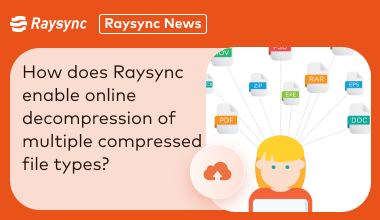How to Synchronize Medical Data Securely and Efficiently?
January 25, 2024Currently, the healthcare sector is rapidly evolving and the seamless flow of healthcare data has become the backbone of effective patient care and operational efficiency. The concept of file synchronization, especially in the healthcare industry, is no longer a luxury but a necessity. In this article, we will delve into the crucial role of medical file synchronization and provide a comprehensive overview of its importance, benefits and the best solution.
Part 1: Importance of Medical Data Synchronization
Medical data synchronization is the cornerstone of modern healthcare. It refers to the process of ensuring that patient records, medical histories, and other crucial health information are consistently updated and accessible across various platforms and devices used by healthcare providers. Healthcare data synchronization is vital for several reasons.
-
Access to Current and Complete Information Reducing Medical Errors
Real-time updates of patient data can minimize or avoid diagnostic errors or inappropriate treatment options. Synchronized medical records help track a patient's progress and help healthcare providers make informed decisions based on the latest clinical data.
-
Cohesive and Coordinated Patient Care
File synchronization enables different specialists – from surgeons to general practitioners, nurses, and pharmacists – to collaborate effectively. This unified approach is especially crucial in complex cases requiring coordinated management across various specialties.
-
Compliance with Legal and Regulatory Standards
Synchronized systems often incorporate advanced security measures like encryption, access controls, and audit trails to ensure that patient data is not only up-to-date but also securely managed.
Part 2: Improving Healthcare Task Efficiency and Worker Effectiveness
Implementing healthcare data synchronization directly translates to enhanced task efficiency and worker effectiveness.
-
With synchronized data, healthcare providers can access and share information swiftly, making patient care more responsive and timely.
-
It reduces the time spent on administrative tasks, such as data entry and retrieval, allowing healthcare workers to focus more on patient care.
-
Moreover, it minimizes the likelihood of duplicate tests or procedures, ensuring more efficient use of resources.
-
Additionally, having synchronized data aids in decision-making processes, as healthcare providers can rely on a comprehensive, up-to-date dataset.
Part 3: Benefits of Adopting Medical Data Synchronization
-
Improved Patient Outcomes
Immediate access to a patient's complete medical history enables healthcare providers to make informed decisions, leading to better patient outcomes.
-
Enhanced Collaboration
Synchronization facilitates easier collaboration among healthcare teams, regardless of their location, ensuring a unified approach to patient care.
-
Increased Data Accuracy
Consistent updates and cross-referencing help maintain the accuracy of medical records.
-
Time and Cost Efficiency
Reduces the time and resources spent on managing data manually, translating into cost savings.
-
Compliance and Security
Adhering to privacy standards and regulations becomes more manageable with synchronized data, enhancing data security and patient privacy.
Part 4: The Best Solution for Medical File Synchronization - Raysync
Raysync stands out as a premier solution for medical file synchronization, offering unique advantages tailored to the specific needs of the medical industry. Here, we delve into the specific benefits that make Raysync an ideal choice for healthcare data management:
-
High-Speed Data Transfer: Raysync, using its proprietary UDP network transmission protocol,leading to faster transfers and fewer corrupted files compared to FTP.This speed ensures that medical professionals have timely access to vital information, crucial for emergency care and routine patient management.
-
Robust Security Features: Raysync ensures this security through various measures like TLS encryption, AES-256 encryption, and two-factor authentication, safeguarding files against unauthorized access and leaks during transmission.This high level of security is vital for maintaining patient confidentiality and protecting against data breaches. Fully compliant with HIPAA requirements for medical file sharing, it ensures the security of patients as well as various medical data.
-
Seamless Integration: Raysync is designed to integrate smoothly with existing healthcare systems, including electronic health records (EHRs), Picture Archiving and Communication Systems (PACS), and other medical databases. This compatibility minimizes disruptions to existing workflows, making it easier for healthcare institutions to adopt and implement the solution without significant infrastructure changes.
-
User-Friendly Interface: Raysync offers an intuitive user interface, making it accessible to all healthcare professionals regardless of their technical expertise. This ease of use ensures that medical staff can focus on patient care rather than navigating complex software.
Conclusion
The integration of file synchronization for the medical industry is not just a technological advancement, but a revolutionary step towards more efficient, secure, and patient-centered healthcare. From enhancing the coordination of care to ensuring data security, the benefits are manifold. Raysync stands out as a premier choice for medical file synchronization, aligning with the industry's needs for speed, security, and efficiency. As healthcare continues to advance, embracing technologies like medical file sync will be pivotal in shaping a more efficient and effective healthcare system.
You might also like

Raysync News
April 12, 2024Many compressed files are transferred to a file server. Users are unable to view or preview them. The ability to unzip files online on the server solves this problem and significantly improves the customer experience in a variety of ways.
Raysync News
December 21, 2023Businesses are becoming more and more demanding about the way they store their files. So how do you choose between file storage, object storage, and block storage? What is the best way to store files?

Raysync News
March 27, 2024Due to the inherent limitations of the UDP protocol, it is difficult to guarantee a stable minimum transmission speed. Therefore, how to limit the minimum speed of UDP transmission has become a technical issue worth discussing.